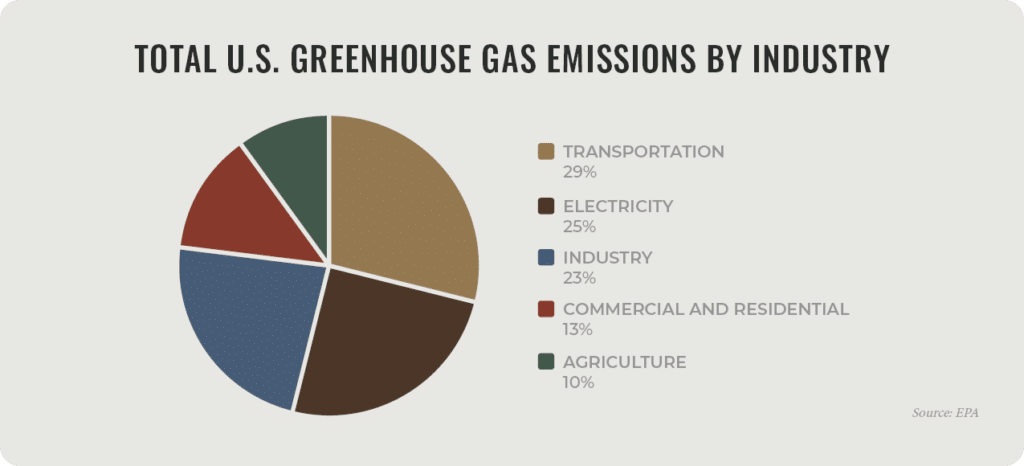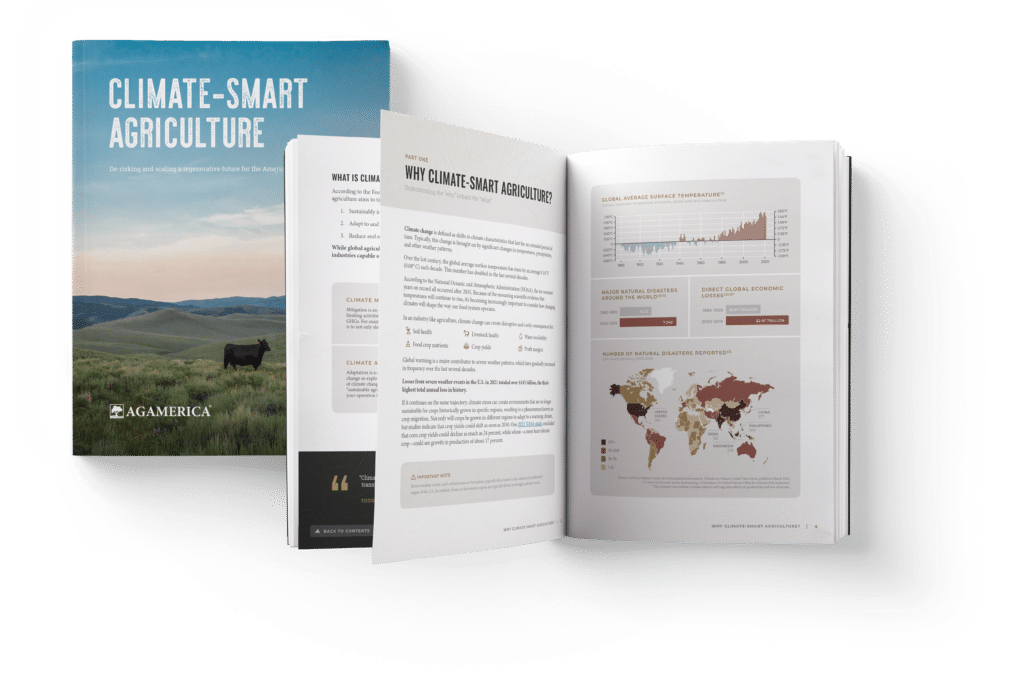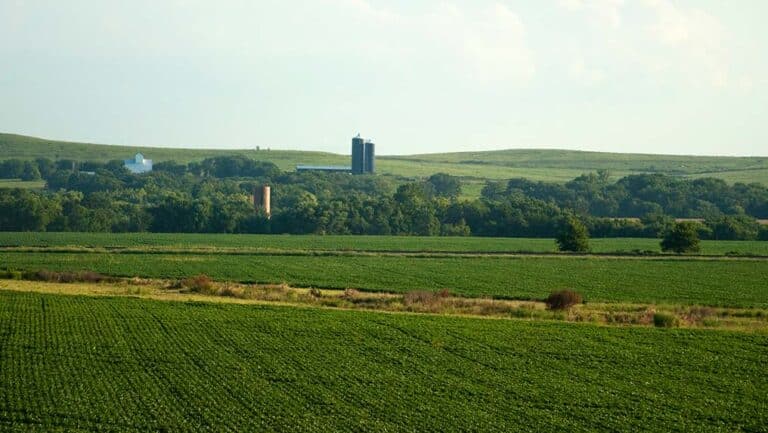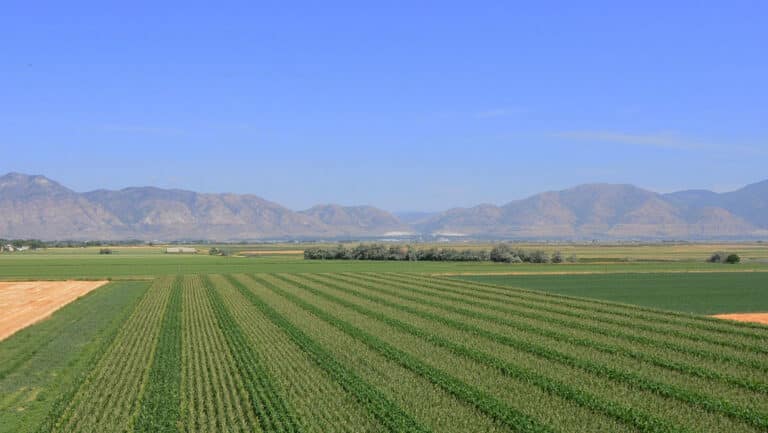Debunking Misconceptions about U.S. Agriculture and Climate Change
U.S. agriculture is essential in mitigating climate change, protecting our natural ecosystems, and sustaining human life.
Despite this fact, agriculture’s role in environmental sustainability is often misunderstood. The information gap between farmers and community members often leads to these misunderstandings, and the lack of knowledge leads to broad generalizations. It’s true—global agriculture is a significant greenhouse gas (GHG) emitter. But it is also a necessity and an integral part of the solution. Agriculture and forestry are unique in that they are the only sectors that can both emit and sequester GHG emissions.

Continue reading to explore the facts behind five common misconceptions about U.S. agriculture’s role in climate change.
Myth #1: U.S. agriculture contributes one-third of total greenhouse gas emissions.
One of the most common misconceptions about U.S. agriculture involves its share of total greenhouse gas emissions. Oftentimes, global numbers are used when making an argument against American agriculture. This is problematic for several reasons:
1. Global numbers do not match U.S. numbers and do not accurately account for the sequestration efforts by U.S. farmer operators.
2. Over two-thirds of the world is comprised of developing countries, where agriculture accounts for a larger percentage of their domestic greenhouse gas emissions.
In 2010, global agriculture, forestry, and other land use contributed approximately 24 percent of global greenhouse gas emissions, with approximately 20 percent of global agriculture emissions offset through carbon sequestration.
In the U.S., agriculture contributed an estimated 10 percent of U.S. greenhouse gas emissions in 2019—the lowest emitting major sector in the country.

Using global percentages for U.S. agriculture emissions does not acknowledge the dedicated action American farmers and ranchers are taking to regenerate their soils, sequester more carbon, and continue feeding a growing population. In addition, agricultural greenhouse gas emissions are measured throughout the lifecycle; however, the emissions from other industries are measured as direct emissions. While the percentage of U.S. agriculture emissions is often misrepresented, so are the impacts of sequestration and climate-smart practices in the ag and forestry sectors. Some of these impacts include:
- U.S. carbon sinks through forestry, grassland, cropland and wetland management offset 12 percent of U.S. greenhouse gas emissions and sequestered 764 million metric tons of carbon in 2018.
- Agricultural soils have the potential to remove four to six percent of total annual U.S. emissions.
- Converting all tillable acres to no-till practices and planting cover crops on 261 million acres of all harvested cropland would have the same impact of removing 53 million cars from the road.
- The ability of ag and forestry sectors to create carbon sinks that can offset GHG emissions makes agriculture one of the most powerful allies in the fight against climate change. According to a USFRA report on climate-smart agriculture, widespread adoption of these practices could reduce U.S. agriculture emissions to less than four percent by 2025.
Myth #2: Methane is more dangerous for the environment than carbon dioxide.
Methane is often cited as a major contributor to climate change. The truth is, methane is more potent than carbon dioxide. The stark difference between methane and carbon dioxide that is less discussed is that it stays in the atmosphere for a shorter period of time. Methane stays in the atmosphere for about 12 years, while carbon dioxide stays in the atmosphere for hundreds or even thousands of years, according to research from the University of California, Davis. This is because methane is part of the biogenic carbon cycle and is removed from the atmosphere through oxidation.
In addition to the natural removal of methane from the environment, methane can also be converted into renewable energy through the process of anaerobic digestion. Across the nation, an increasing number of farmers are incorporating digesters onto their operations that convert cow byproducts to a renewable energy called biogas.
But the environmental benefits of animal agriculture don’t end with anaerobic digestion.
Myth #3: Animal agriculture is not an important part of our ecological system.
Although animal agriculture is a popular target in the climate change discussion, the truth is that cows and other ruminants produce less than four percent of all U.S. greenhouse gas emissions. In fact, the U.S. beef industry has one of the lowest carbon footprints in the world—contributing two percent of direct emissions in the U.S.
Animal agriculture is necessary for a healthy ecosystem because grazing helps to restore healthy nutrients to the soil and preserves wildlife habitats. In this way, it plays a significant role in farmland conservation. In the U.S., 528 million acres consist of range and pasture lands. Because the majority of farmland is unable to support crop growth, without grazing cattle, this land may be developed. In turn, the land’s carbon sequestration potential would decrease. According to the 2017 U.S. ag census, total U.S. farmland declined by more than 14.3 million acres from 2012 to 2017. According to The American Farmland Trust, an average of 2,000 acres of farmlands in the U.S. are converted to residential and commercial properties each day.
Not only does animal agriculture play a role in preserving how much American farmlands we have, but it also preserves the quality of the land through rotational grazing land management.

In addition, livestock consume more than 2.1 billion tons of waste from food, fiber, and biofuel production each year—making them an essential contributor in the fight against food waste.
As a result of their dedication to sustainability, U.S. cattle ranchers have decreased carbon emissions by 40 percent from 1961 to 2018 and reduced methane emissions per unit of beef by 10 percent from 1990 to 2016. Likewise, U.S. dairy farmers reduced methane emissions by unit of milk by 25 percent and they aren’t stopping there. The Innovation Center for U.S. Dairy has set a sustainability goal of achieving net zero emissions by 2050.
Myth #4: Corporate farms are factory farms.
The term “industrial farms” has been thrown around to describe the fear that corporate America is taking over our domestic food system. Many families choose to structure themselves as a corporation to protect their personal assets. Therefore, the label of “corporation” doesn’t mean that a farm isn’t family owned. According to the USDA, nearly 98 percent of farms are family farms. Not only do these farms make up a large portion of total farms, but they also contribute close to 88 percent of the total value of U.S. ag production.
The reality is family farms are still very much the ones who are fueling our nation and keeping our domestic food system secure.
Myth #5: Regenerative farming practices will reduce farm profit margins.
One roadblock that often stands between farmers and regenerative farming practices is the concern that integrating climate-smart practices into their operation will be more costly than sticking with conventional practices. However, it is important to understand that an increase in profit does not always occur instantly. For example, cover crop introduction can initially increase input costs. However, once implemented correctly, producers often reduce synthetic fertilizer costs and see substantial improvements to soil health. For instance, in a survey of 746 farmers, 58 percent experienced soil benefits less than two years after planting cover crops.
According to seventh-generation Iowa row crop farmer and CEO of Continuum Ag Mitchell Hora, the return on investment of cover crops far outweighs the initial costs. Ultimately, cover crops reduce fertilizer use and input costs, benefiting the environment and the profits of farmers. In 2021, Continuum Ag saved customers an average of $106.24 per acre in fertilizer costs alone. Carbon cost-share programs also provide an additional financial incentive for farmers to get involved.
“The impact, even in just 3 years since we’ve introduced some of these practices on a lot of our acres, is huge. We’ve been able to better withstand large rainfall events, cut back on some residual herbicide usage, and are on the cusp of beginning to run some trials to see if we can scale back our nitrogen program due to overall increased efficiency of our soil as a whole and the credit that our legume covers are giving us.”
Financing Customized to Support Your Sustainability Journey
Agriculture is a powerful force in solving our world’s climate change issues. By implementing regenerative practices, American farmers and ranchers are already having an impact on reversing the course of climate change while feeding a growing population. In order to implement these practices, farmers need the financial resources to make them happen. AgAmerica is dedicated to empowering farmers through our flexible financing programs that meet the upfront cost of implementing regenerative practices with the option to convert to more conventional loan terms when the time is right.
Learn more about the benefits of climate-smart agriculture and how to get started in our whitepaper, “Climate-Smart Agriculture.”







